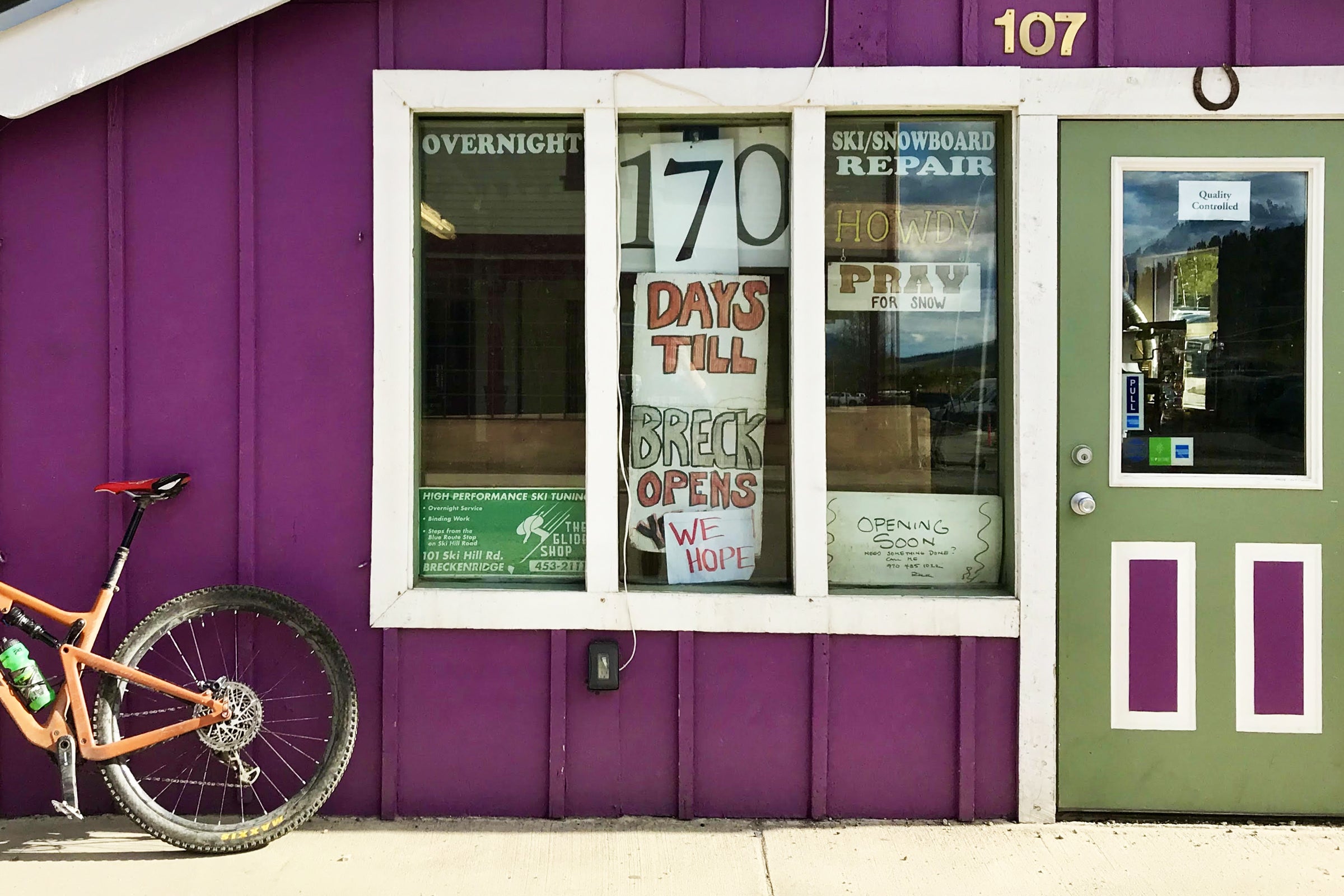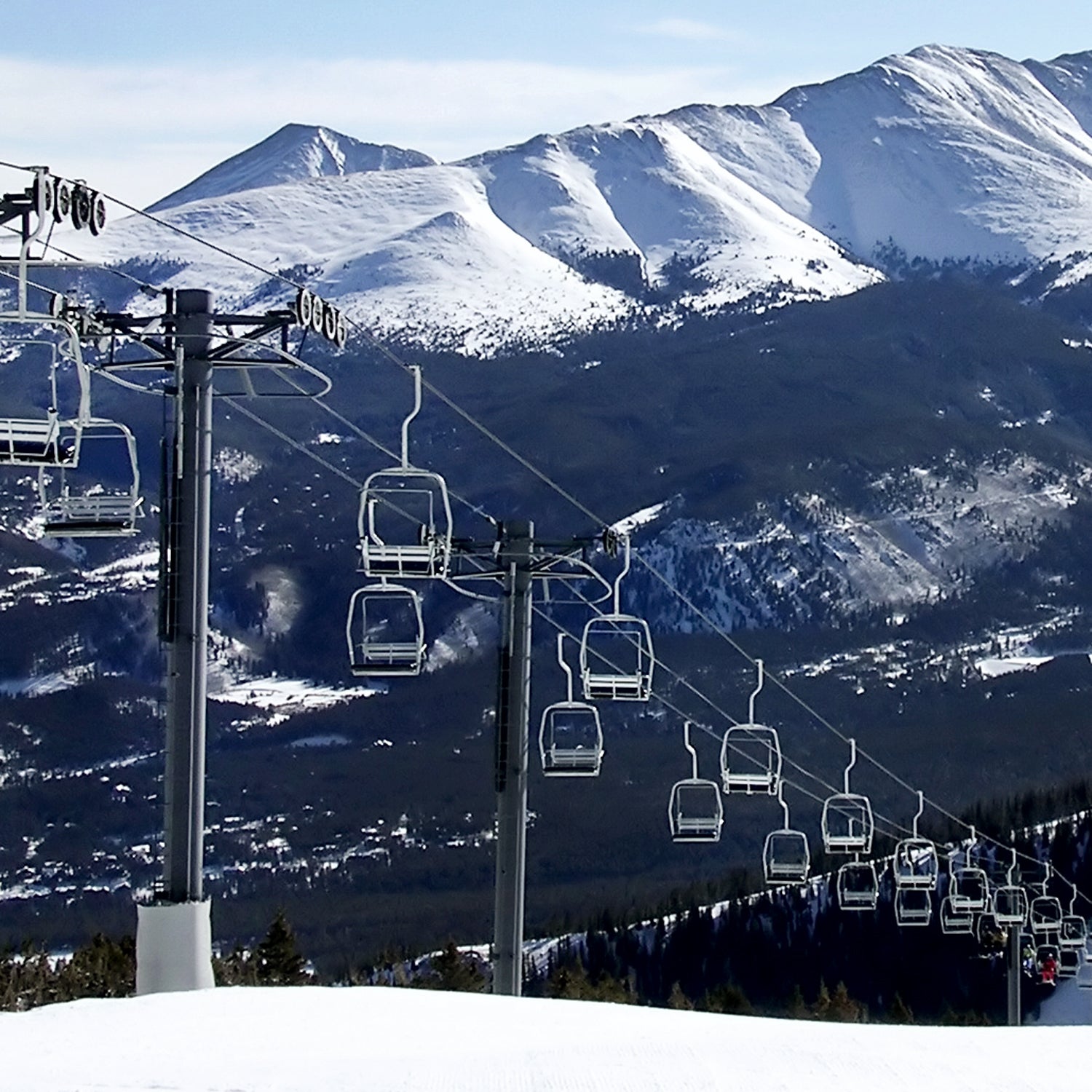Jeffrey BergeronÔÇÖs phone started ringing at all hours the third week of March, soon after his adopted hometown of Breckenridge, Colorado, shut down due to the COVID-19 pandemic. A native of Brockton, Massachusetts, on BostonÔÇÖs gritty South Shore,╠řBergeron moved to Breckenridge in 1975 when he was 20. HeÔÇÖs represented the townÔÇÖs 5,000 residents as a councilman for more than a decade. Known by his nom de plume, , the 66-year-old media personality describes himself as ÔÇťkind of a freak,ÔÇŁ which makes him a man of the ski-town people in a way that most elected officials are not.
Breckenridge was founded as a mining town in 1859. It existed for more than a century before a tiny ski resort opened there in 1961 on 12,998-foot Peak 8. Now╠ř╠řis among the biggest and busiest in the country, routinely notching more than 1.6 million skier visits as one of the most popular destinations on Vail ResortsÔÇÖ vaunted Epic Pass. Last year╠řthe town╠řrecorded $658 million in taxable sales by local businesses.╠řMultimillion-dollar homes are in vogue the way two-room cabins once were. Bergeron has accepted the growth like ski bums accept summerÔÇöbegrudginglyÔÇöwhile always striving to defend the easygoing╠řvibe he fell in love with 45 years ago,╠řwhen he and a friend puttered down Main Street in their 1962 VW Squareback.
So╠řthis March, when nearly a dozen longtime residents called Bergeron, on the verge of sobbing, unsure what they were going to do or if they would be able to stay, the pandemic hit home in a way that no bottom line could. ÔÇťIn many cases, these were dudes in their forties╠řwho I ski with or lift weights with, and they were fighting to maintain their composure,ÔÇŁ Bergeron told me. ÔÇťThey thought they were taking the next step to their futureÔÇöthey finally had a business and property. Then, within five days, everything was tenuous.ÔÇŁ╠ř

Anyone living in a ski town like Breckenridge, the place I have called home for 18 years, knows how drastic this economic and lifestyle crash has been. Take Downstairs at EricÔÇÖs, a popular family restaurant on Main Street owned by the town mayor, Eric Mamula. EricÔÇÖs had set revenue records for seven straight years entering 2020. It appeared primed to do that again, with unprecedented sales in January and February and a booming start to March, typically the richest month of the year for╠řBreckenridgeÔÇÖs╠řlocal businesses. Just up Ski Hill Road, at the base of Peak 8, Breckenridge Grand Vacations (BGV), which sells luxury time-shares and manages nearly 900 lodging units, was on pace to notch the highest sales total╠řin its 32-year history.
Then on Saturday, March 14. Two days later, the town shut down its restaurants and bars, and all tourists were asked to leave by the end of the week. Their departure left much of the community out of work. BGV, the largest year-round employer in Summit County, furloughed more than 500 staff, or 85 percent of its workforce. Vail Resorts laid off or furloughed almost all of its local employees for up to six months. It was as if an ice age had arrived while everyone was sleeping, and we woke up to a place╠řfrozen in time. Retail shops that had been short-staffed all winter replaced their ÔÇťHelp WantedÔÇŁ signs with COVID-19 closure notices. I walked down the double yellow line on Main Street for blocks without seeing a carÔÇöor a person.
Breckenridge has endured its share of local and global calamities, from╠řrampant mine closures to 9/11╠řto the Great Recession. But the last real threat to the townÔÇÖs identity was the 1980ÔÇô81 winter, when the resort only opened for brief stretches and closed for the season in March, after recording just 86 inches of snow╠ř(an average season sees around 350 inches). The population exodus was so dramatic that someone posted a sign on Main Street that read╠řÔÇťLast One to Leave, Turn Out the Lights.ÔÇŁ Twentieth Century Fox, which owned the resort at the time, made sure that never happened again, investing in snowmaking and installing the worldÔÇÖs first high-speed quad chairlift the following year. ÔÇťThat event was not even in the same galaxy as this pandemic, as far as fostering insecurity about the future of our town,ÔÇŁ Bergeron says.╠ř
Over the past two months, mountain towns around the world have adjusted to an uncomfortable, indefinite standstill. March and April are typically economic windfalls, and some resorts stay open through May, including Breckenridge. After the pandemic hit, businesses small and large, as well as nonprofits and municipal governments, slashed their budgets, anticipating annual revenue losses of 40 to 50 percent. Locals hunkered down like marmots in a blizzard. The (where I worked before starting a freelance career) published 12-page newspapers when theyÔÇÖd normally be four times╠řas thick,╠řand it solicited donations from readers. The only companies hiring in the classifieds were Waste Management, the hospital, and WendyÔÇÖs.
According to ╠řreleased on March 24, we can expect to see a $400 billion decrease in U.S. travel spending this year,╠řincluding $350 billion in domestic travel, which is╠řBreckenridgeÔÇÖs bread and butter. ÔÇťThis is seven times the impact of 9/11,ÔÇŁ╠řthe report stated. Local property manager Toby Babich, who serves as president of the international Vacation Rental Management Association, told me that bookings from May through August were down 80 percent from the previous year in╠řtraditionally powerhouse destinations like Florida and the Gulf Coast, and down 40 to 60 percent in mountain towns. Bergeron says he wouldnÔÇÖt be surprised if Breckenridge loses 15 percent of its population. (In addition to the 5,000 year-round residents, there are also hundreds of seasonal winter workers.) Aside from those who move back in with their parents to escape the areaÔÇÖs high cost of living, itÔÇÖs unclear where they would go.
To help locals get by, in late March, the town dipped into its $20 million rainy-day fund and established rent-assistance pools for small businesses and those who work in town. Nearly 210 business owners applied for April aid, receiving an average of $3,000 from a $1 million╠řfund, while 900 residentsÔÇÖ rent handouts were drawn from a pool╠řof $500,000. The point was to spread out the body blows. ÔÇťBefore the town chips in, weÔÇÖve been going to landlords and saying, ÔÇśHey, youÔÇÖre owed this much, what will you take?ÔÇÖÔÇŁ Bergeron says. If the landlord doesnÔÇÖt cooperate, neither does the government.╠řOther ski towns, like , have done similar things, while in Jackson, Wyoming, are filling the benefactor role. Still, not every ski bum is protected. In Stowe, Vermont, the only rent assistance available is what people can procure from the feds, says town planning director Tom Jackman.╠ř
Everyone has feared a mental-health crisis as part of the pandemic, and for a while,╠řit appeared Breckenridge might avoid that fate. Testing for the virus╠řramped up in mid-April╠ř(as of this writing, 243╠řpeople had tested positive in Summit County, with 47╠řhospitalizations and one death), and talk of reopening began. Then two local teenagers committed suicide eight days apart in late April, sending the community into shock. ÔÇťI think we can say confidently that the isolation was a factor in the emotional rawness of these kids,ÔÇŁ says Jen McAtamney, executive director of , a local mental-health nonprofit.╠řÔÇťBecause theyÔÇÖre╠řsupposed to be socializing, and their brains are developing right now, so itÔÇÖs hard for them to see the other side of thisÔÇöthe future.ÔÇŁ Building Hope funds up to 12 therapy sessions for anyone in need, often starting as soon as a person╠řapplies. ÔÇťWeÔÇÖve been getting as many calls in a day as we usually get in a week,ÔÇŁ McAtamney says.
What does the future look like for Breckenridge and other ski towns? Much depends, of course, on how long the pandemic lasts. ÔÇťI describe it, frankly, as unrolling a snowball,ÔÇŁ says Robin Theobald, a fifth-generation Breckenridge resident and prominent local businessman. ÔÇťA snowball will roll down the hill on its own, but how do you put that back on the hill? You canÔÇÖt unroll it.ÔÇŁ Town manager Rick Holman says he expects to see a $190 million decrease in sales this year, compared with 2019. Already╠řat least one Main Street shop has gone under, with more likely to follow. Many businesses received federal assistance to cover payroll and overhead, but that doesnÔÇÖt solve the biggest problem: a lack of visitors spending money.╠ř
All lodging properties were shut down through May but were allowed to reopen June 1. The Breckenridge Tourism Office was targeting July 4 as its official summer kickoff, then changed course and decided not to stage any major events, to prevent large crowds. Main Street, typically clogged by traffic, is being turned into a pedestrian throughway, giving people more room to avoid each other. BGV plans to have its guests sign a pledge to abide by public-health orders upon their arrivalÔÇöa provision many locals support, given their wariness of letting outsiders back in without treatment or a vaccine for the virus. The ÔÇťBGV PromiseÔÇŁ requires guests to cover their faces anytime theyÔÇÖre outside their rooms at the resort, unless theyÔÇÖre eating, drinking, or playing in the pool. ÔÇťWeÔÇÖre trying to avoid conflict among our guests,ÔÇŁ says company CEO Mike Dudick. If visitors refuse to wear masks inside a retail shop or a restaurant downtown, as mandated by government officials, the townÔÇÖs delicate dependence on tourism could come to a head.
ÔÇťI think thereÔÇÖs going to be a philosophical discussion for locals to have,ÔÇŁ Dudick says. ÔÇťBecause those who were in the camp of╠řWe have way too many tourists, now theyÔÇÖve gotten to look squarely down the barrel of what it looks like with zero. So what kind of economy do we really need to live in this community? WhereÔÇÖs the balance point?ÔÇŁ
Mayor Mamula, who was╠řreelected in early April, and whose father was the mayor 20 years ago, envisions one potential silver lining that could extend to ski towns everywhere. With many service workers earning between $25,000 and $30,000 a year, homeownership╠řis often out of reach, a major reason why locals leave to raise their families elsewhere. ÔÇťMaybe some housing goes on the market when we come out of this, and people who have lived here for a long time are actually able to afford it,ÔÇŁ Mamula says. ÔÇťThatÔÇÖs what IÔÇÖm hoping for: we get a shake-up in the economy, where some of the people who have used this as strictly a place to make money and not a place to live will get replaced by people who want to live here.ÔÇŁ ItÔÇÖs an attractive prospect on paper, but April Norton, director of WyomingÔÇÖs Teton County Affordable Housing program, says early signs in Jackson Hole leave her worried.╠řÔÇťI see it going the other way for us, which is really scary,ÔÇŁ she told me.
Ironically, two bases that have been assailed by locals who feel Breckenridge is too busyÔÇöday-trippers╠řfrom the Front Range and time-share occupantsÔÇöare likely to play a crucial role in kick-starting the economy. But how many destination travelers join them, and when, is the wild card. Breckenridge Tourism Office CEO Lucy Kay told me the organization has spent ÔÇťvery littleÔÇŁ of its $1.2 million summer advertising budget, which is used to attract visitors from out of state. ÔÇťWe donÔÇÖt want to bring in too many people too fast,ÔÇŁ she says. ÔÇťWe want to see how much fills organically.ÔÇŁ The long-term prognosis remains unpredictable, like the virus. ÔÇťYou could take this out to a worst-case scenario, where we lose part of next winter, and that could be devastating,ÔÇŁ says Mamula, whose restaurant employs 48 people, four of whom tested positive for COVID-19 in May. ÔÇťThen I donÔÇÖt╠řknow what happens. I donÔÇÖt╠řeven want to think about that right now.ÔÇŁ
╠ř
Theobald believes there is too much money invested in Breckenridge by wealthy vacationers for its economy not to recover. Urban residents still pine for mountain escapes, perhaps now more than before. But if you ask Bergeron, the biggest threat is qualitative, not quantitative.╠ř
╠ř
ÔÇťThe people who have called me in a state of panic really reflect what this place is about, and yet they might have to leave,ÔÇŁ Bergeron says. ÔÇťTheyÔÇÖd be replaced eventually by people with the same occupation╠řbut who donÔÇÖt have the historical understanding of what our town is. And that could really change what I think is the best part about BreckenridgeÔÇöthe character. ItÔÇÖs forgiving, freewheeling, and a remarkable place to live.ÔÇŁ


